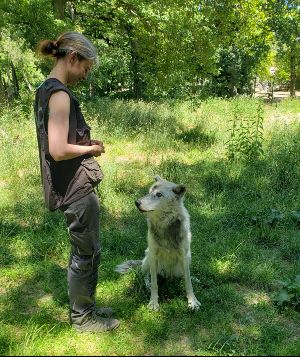The World That Cried Wolf
Brandon Kirk Harris (Intern)
10.09.2022

I came here from the American West, where wolves have mostly been missing from the wild landscape since the 1930s, a victim of a national government campaign of extirpation based in fear and misunderstanding. The results were catastrophic. When the wolves went away, the American elk lost their greatest predator. Instead of constantly moving, the elk could now settle in the lowland river valleys and have their pick of the shrubs along the shore, like the willows and aspens. Suddenly, these shrubs could not grow into trees, and so the beavers had no wood with which to build their dams, and all of the animals and plants who made their home in the lakes behind the dams were suddenly without. Where the aspens and willows disappeared, the birds that migrated had nowhere to roost along their journeys, so they opted to skip these regions altogether, taking with them seeds that could provide new plant growth. The elk then overgrazed on the native plants, exposing the rodents beneath to more predators, whose role was also to carry seeds and help to germinate them. This made way for invasive species from Europe and Asia to take root.
With the wolves gone, the coyote suddenly had no more competition, and overwhelmed the small herbivores of the region with its numbers, driving the foxes away. Without the wolves to keep them in place, the coyotes expanded across North America, and now inhabit almost every part of the continent from Alaska to Panama. When the wolves went away, what was once a rich ecosystem with a plethora of various animals and plants could be boiled down mostly into enormous populations of invasive plants and American elk, who with their populations so large, succumbed more readily to disease. In 1995, wolves were brought back to the American West at Yellowstone National Park. Within a few years, all of those changes had reversed: the elk were driven back up into the mountains as the seasons changed, tilling the soil as they moved and freeing the aspens and willows to grow. This heralded the return of the beavers and the migratory birds. Wolves have since expanded across the Northern Rocky Mountains, and can be found slowly migrating south, to the states of Colorado and California.
People fear wolves because we are told - through bedtime stories, myths, and fairy tales - that they are dangerous predators. We are warned how they will feast upon our livestock indiscriminately. We believe they will stalk us in the dark woods and devour our children. We know wild packs kill the herds we hunt and would drive their numbers into oblivion. We are told wolves are senseless beasts who rove in brutal hierarchical packs with an alpha, beta, and omega. A ‘lone wolf’ is the greatest threat to our community.
Having just completed my Master’s Degree, focusing on the populations of American Gray wolves, I can say with certainty that nothing could be further from the truth. Wolves are generally scared of humans, opting to stay clear of where they gather. Wolves make herds of ungulates (like elk and deer) more healthy by preying on the old and the weak members, thus reducing the herd’s susceptibility to infectious disease. And while wolves will certainly prey on livestock if given the opportunity, they can be discouraged from doing so, especially given how close it brings them to humans. As well, there is a wildly disproportionate effect that wolf predation has had on North American and European livestock as compared to infectious disease. In 2019, in the American state of Idaho, there were a recorded ~200 livestock deaths from canids, compared to over 40,000 from various diseases. As to their behavior, wolf societies are incredibly intimate: packs are composed of family units, overseen by a mated pair. A pack is composed of this pair’s children, and occasionally, siblings. Lone wolves rarely exist in the wild, except in cases where a wolf leaves their pack to find a mate and start a new family of their own.
These fears of wolves run deep in the human psyche, and aren’t exclusive to the United States and Canada. I’ve heard these same arguments against reintroduction said and printed in Scotland, and the same fears of incoming wolves echo across Central Europe. Now, more than ever, it is important to recognize how pivotal these animals are to the world around us. The beasts of our imaginations are not the animals of reality. I hope that visitors who come to the WSC come with open minds and open hearts. I hope they have the opportunity to see these awe-inspiring animals face-to-face, and learn to break out of that tradition of fear. Through the work being done at the WSC, I hope everyone will come to see wolves how I see them: as fellow creatures of this earth, just trying to survive and care for each other. Plus, anyone who’s seen the antics of WSC resident Wamblee knows how lovely these animals truly are.